A Private Tour today, in North Norfolk. It was a lovely sunny day again, with mostly blue skies and only the occasional patch of high cloud, but still with a bit of a chill in the NE wind.
We started at Stiffkey Fen. As we got out of the car, we looked across to see a couple of Brown Hares in the meadow the other side of the road. They started to chase each other round and round and were quickly joined by two more Hares. Them they started boxing, rearing up on their hind legs and hitting out at each other with their front ones. It was great to watch!

There were a couple of Stock Doves in the field too, but they had disappeared by the time we had finished watching the Hares. One flew past as we walked along the permissive path and when we got to the copse an impressive flock of 11 Stock Doves flew in and landed over the ridge.
It was starting to warm up nicely now and our first Marsh Harrier of the day circled up out of the valley below. A Sparrowhawk emerging from the wood beyond was chased by a Jackdaw but wasn’t going to just take it and started to chase the Jackdaw back, before it dropped back down into the trees.
As we walked into the copse, we could hear a Blackcap singing, a lovely melodic song, and two Chiffchaffs having a sing-off against each other. A Robin and a Wren were singing too, the latter certainly punching above its weight in the volume stakes!
There were lots of House Martins and a couple of Swallows flying around the house on the hill, as we got out of the trees. We could hear all the Avocets on the Fen alarm calling as another Marsh Harrier passed over.
As we made our way along the path to the seawall, we could hear a pair of Bullfinches piping in the sallows and had a couple of glimpses as they flew off ahead of us and then back round behind us. A Sedge Warbler was more obliging – sitting up in the reeds singing. As we got up onto the seawall, we could hear a Cuckoo singing. It was over in the poplars at the back of the Fen today and showed no signs of coming out so we could see it.
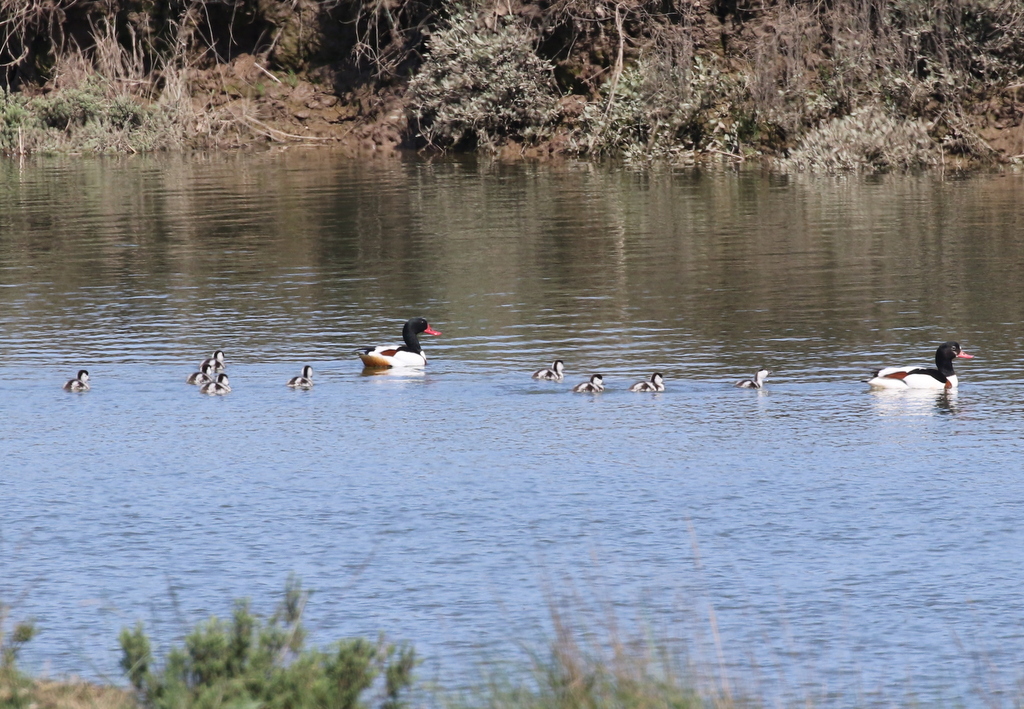
The tide was still coming in out in the harbour. An Oystercatcher was down on the mud by the first sluice and a Redshank was on the other side. A pair of Shelducks were escorting their ten Shelducklings down the channel. Further out on the saltmarsh, we could see there were still good numbers of Brent Geese lingering. A Spoonbill flew in across the saltmarsh on the edge of the harbour, but continued on straight east past us.
There were not so many waders on the Fen again today. We managed to find one Common Sandpiper, feeding along the edge of one of the islands, before it flew behind the reeds. There were at least three Little Ringed Plovers displaying, flying round over the reeds with bat-like wingbeats, calling. Otherwise, their was just one Black-tailed Godwit feeding in the deeper water, and the regular Avocets.
A pair of Teal dropped in on the water – common here in winter, but more unusual at this time of year. There was a pair of Tufted Ducks out here too, but otherwise not so many ducks now.
As we walked along the seawall towards the harbour, a Common Whitethroat was singing from the top of a small hawthorn bush ahead of us. A Linnet was singing in the top of the hedge by the path as we continued on.
There were a few waders around the muddy edges of the harbour, gathering ahead of the tide. A large roost of Oystercatchers were mostly sleeping away on one side. On the stonier spits, we could see several distant Turnstone among the Brent Geese and a little flock of Ringed Plover accompanied by a single Dunlin. Two Whimbrel which landed distantly out on the saltmarsh were hard to see given the heathaze.
Out on the end of Blakeney Point, we could see a small number of seals hauled out on the sand through the scope. A party of nine Gannets flying past over the sea beyond stood out as their mostly white plumage shone in the morning light. A Marsh Harrier passing over the Point upset the Black-headed Gulls and Sandwich Terns which all whirled round over the dunes. We could see a few Common Terns and Little Terns out over the harbour too, and a single Common Tern flew past us and up the channel.
One of the Marsh Harriers flew in over the saltmarsh and we could see it circle back where the Shelducklings were back in the channel. One of the adult Shelducks flew up and started to mob it, chasing round after it. The Marsh Harrier stooped a couple of times but appeared to come up empty talonned. When we got back along the seawall, we could see that the brood was still intact. Walking back along the path towards the road, we had great views of the Marsh Harrier as it circled low over the trees ahead of us, before flying off over our heads.
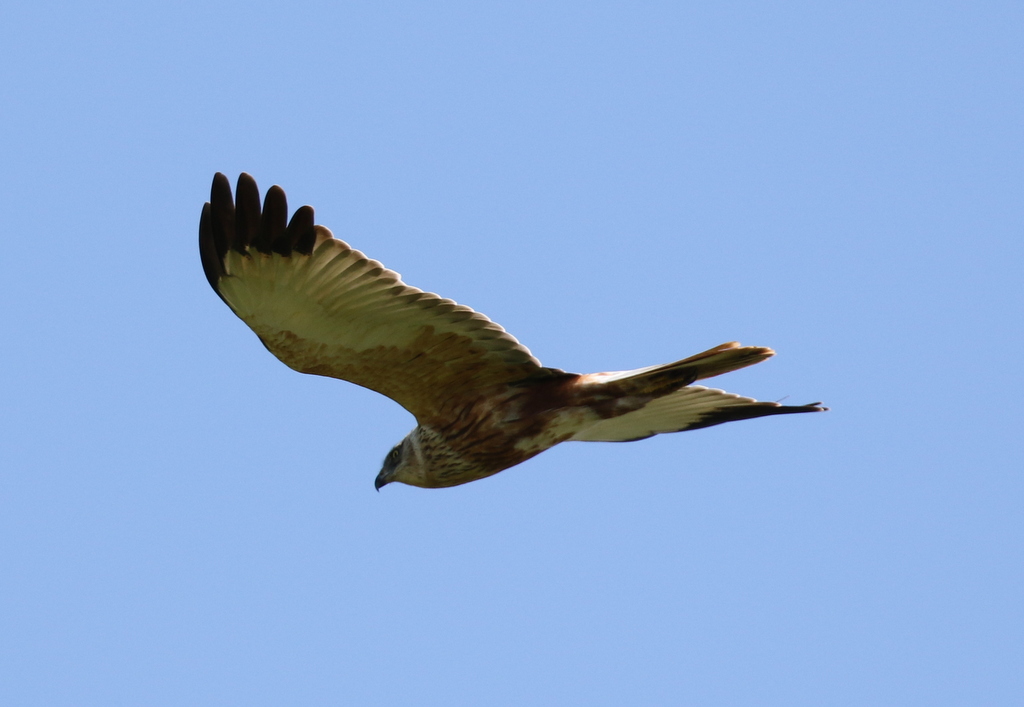
With the warmer weather, there was a nice selection of butterflies out today. We watched a Green Hairstreak ovipositing and had nice views of Speckled Wood along the path. There were quite a few whites out again – Green-veined White and Small White – and several Red Admirals today. More dragonflies were out too, with Four-spotted Chaser, Azure Damselfly and Large Red Damselfly all seen along the path.
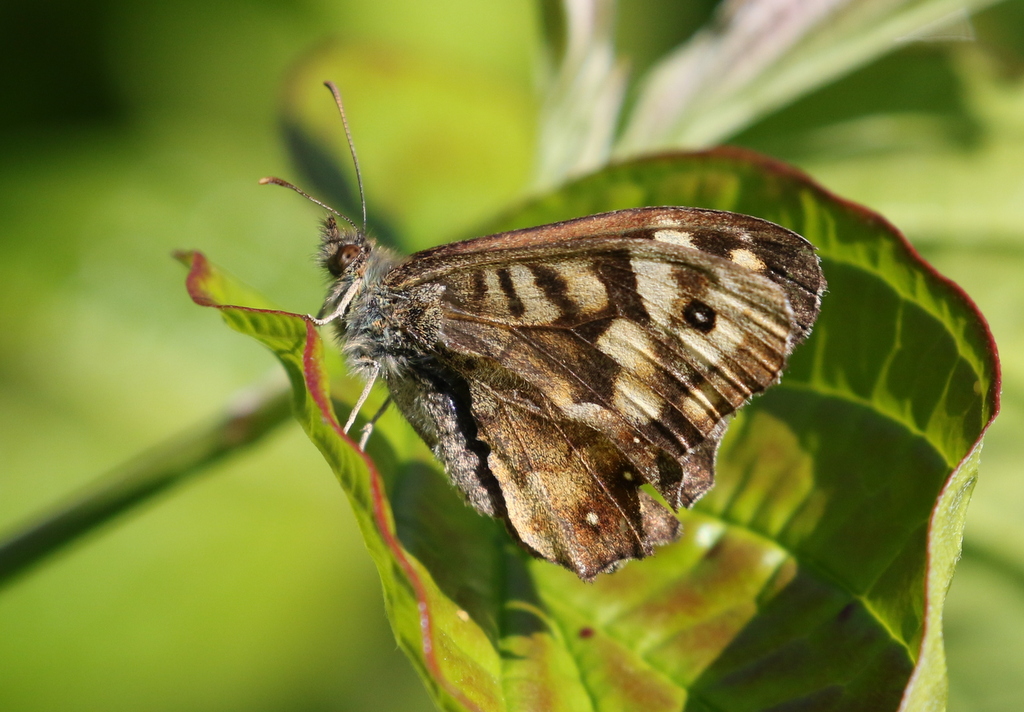
We made our way round to Cley next and headed straight out to the hides. Along the Skirts path, several House Martins were coming down to collect mud from the pools just behind the cattle pens.
A Reed Warbler was skulking in the reeds singing, just the other side of the main freshwater channel, although it did hop out briefly. A Sedge Warbler singing from the top of a bush by the boardwalk was much more accommodating, as was a Reed Bunting. We heard a couple of Bearded Tits calling and saw them zipping across over the reeds a couple of times, but not the views we were hoping for here.

It was rather cold in the hides again today, out of the sun. We had a look at Whitwell Scrape first. The highlight was the Avocets nesting on the island in front of the hide. The nest which had one chick hatched a couple of days ago is now empty, but the birds were still sitting tight on the other two nests. We watched a couple of changeovers, and one of the birds kept fidgeting and turning its eggs – perhaps they are about to hatch?
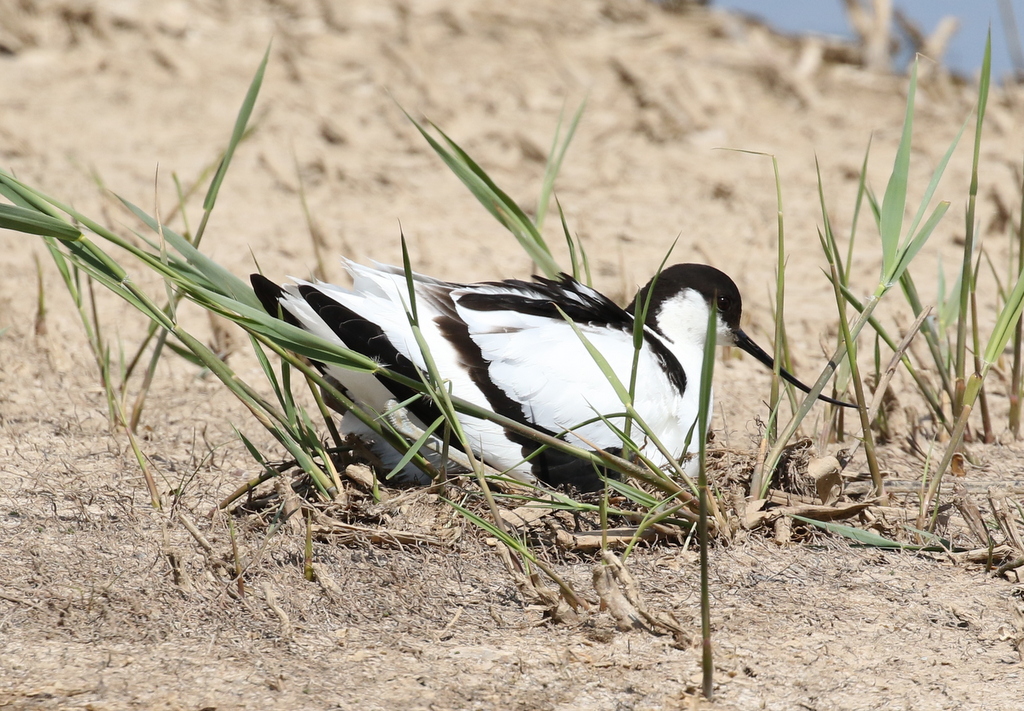
Otherwise, there was a nice pair of Gadwall feeding just below the hide and we stopped to admire the intricate patterning on the drake. The connoisseur’s duck! While scanning carefully round the edge, the surprise was a Common Snipe hiding in the reeds at the back, the first we have seen here for a while, with most of the birds which spent the winter here long since having left.
There were more birds on Simmond’s Scrape, so we made our way round to Dauke’s Hide. There are still good numbers of Black-tailed Godwit and in with them we found a single Knot, still in its grey non-breeding plumage. Two Greenshanks were feeding nearby.
There were two Ruff on here, both getting their smart ruffs. One was largely dark, with a barred ruff, whereas the other had a mostly white head and neck. Over on Pat’s Pool we could see another three Ruff, including a particularly striking bird in full breeding plumage, with a bright rusty coloured ruff and ornate crest. Stunning to look at!
There were four more Greenshanks on Pat’s Pool too – there had obviously been an arrival of them this morning, stopping off to feed up on their way north. But we couldn’t find any sign of the Temminck’s Stints on the scrapes here today.
It was nice to get out of the hide to warm up, and we made our way slowly back. The breeze had picked up a little, and there was no sign of any Bearded Tits now. They were clearly keeping their heads down! The highlight of the walk back was a brood of Shoveler ducklings accompanied by the female in the freshwater channel by the bridge.

After lunch back at the Visitor Centre, we made our way round to the East Bank. As we walked out, we could hear Bearded Tits calling, but we couldn’t see them down in the reeds. A Lapwing put on a fine display though, flying round, singing, twisting and tumbling. We thought it was great – the female Lapwing down in the grass had her back turned and was clearly unimpressed!
There were two Spoonbills busy feeding in the Serpentine, walking up and down sweeping their bills from side to side. Before we got to them, we stopped to admire a summer plumage Turnstone, down on the mud below the bank. Through the scope, we could see the lovely rich chestnut patterning in its upperparts. While we were watching the Turnstone, the Spoonbills stopped feeding and suddenly flew, landing again in a ditch over the back of Pope’s Marsh.
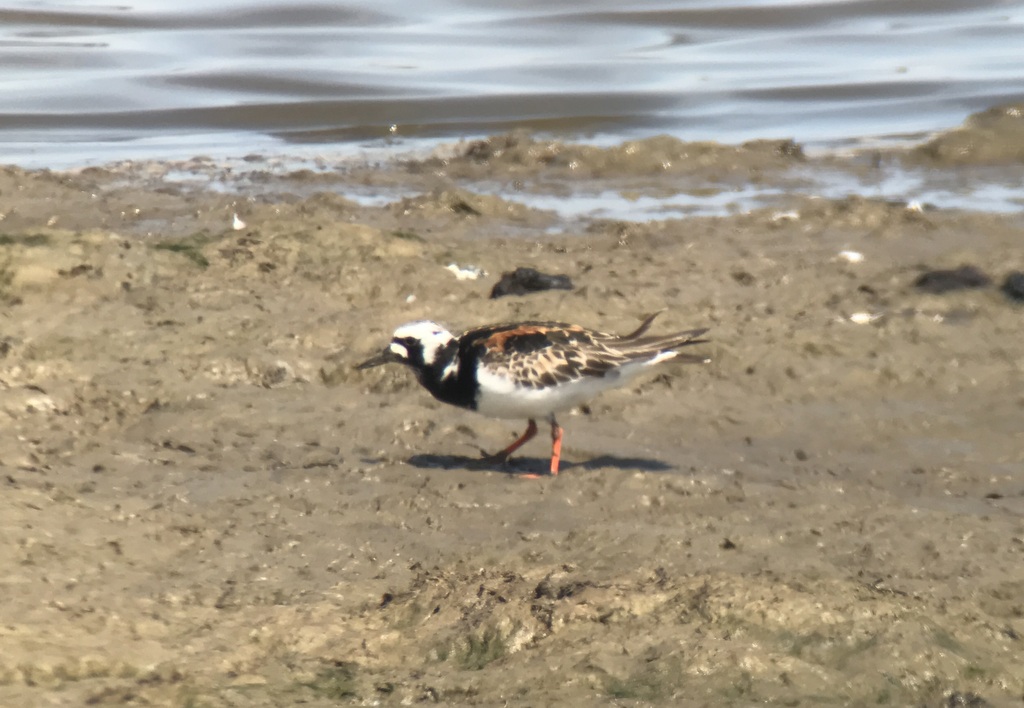
There were a few more waders out on the pool at the back, including a couple of Sanderling and a mixed flock of Ringed Plovers and a couple of Little Ringed Plovers feeding on the open mud. The drake Wigeon was still on the north end of the Serpentine – it shows no sign currently of heading off for the breeding season.
Just before we got to the main drain, we heard a Bearded Tit calling again and looked across to see one fly in and dive down into the reeds just a foot or so in from the edge. We stood for a while, hoping it might work its way through to the edge of the ditch but, despite it calling again several times, it never did show itself. A pair of Reed Buntings put on a much better show and even the Reed Warblers perched up nicely in the sunshine.
We continued on to Arnold’s Marsh, where a noisy group of Sandwich Terns had gathered on one of the islands. Through the scope we could see their bushy crests and yellow-tipped black bills. There were a couple of Little Terns with them too. There were a few more Turnstones out here and a handful of Redshank. The highlight was a pair of Little Ringed Plovers which were on a sandy area in the edge of the saltmarsh down at the front. Through the scope we had a great view of their golden yellow eye rings.
A quick visit to the beach produced more terns flying back and forth close inshore over the sea, including several more Little Terns. Then we started to make our way back.
The Spoonbills had done a circuit and returned to the Serpentine. When we got back, one of them was still busy feeding out in the water and we had a great look at it through the scope. It appeared to be finding lots of food – it kept flicking its head up out of the water.
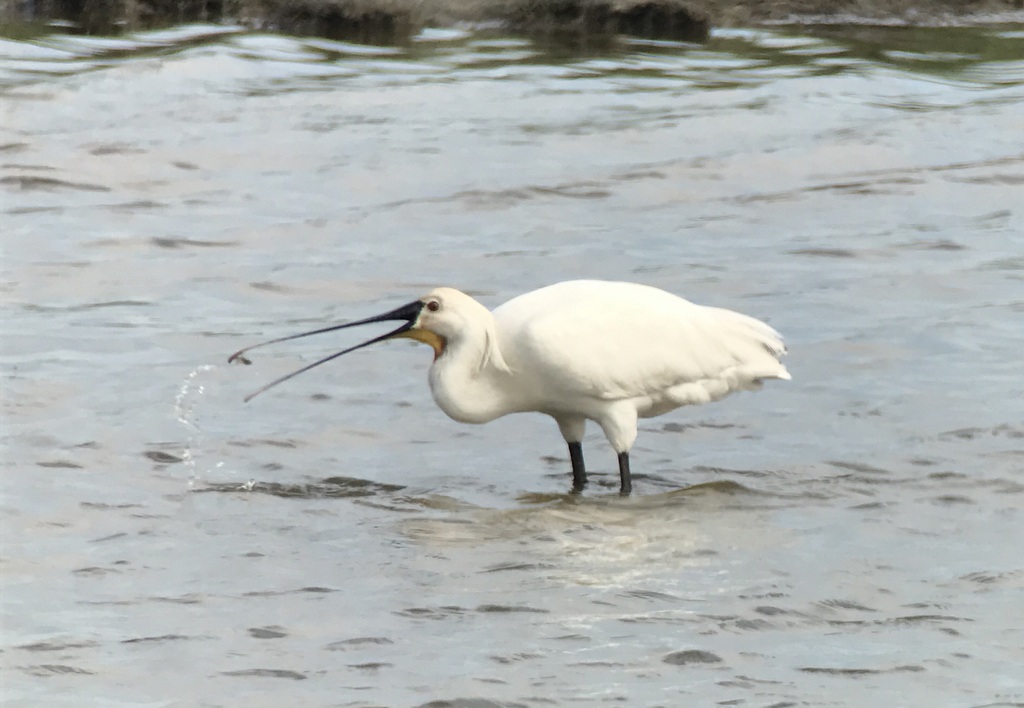
We were almost back to the car park when we heard a Bearded Tit call and looked over to see two birds chasing each other into the reeds not far from the bank. We stood again and watched and didn’t have to wait too long before they came up again.
We could see there was a male Bearded Tit chasing after a female, but they disappeared down into the reeds again. The third time they came up, they landed higher up in the reeds and the male shuffled up a stem and perched in full view. Finally!

It had been worth the wait, as we now had a fantastic look at the male Bearded Tit. We could see its powder blue-grey head and black moustaches. It stayed in the same place for a minute or so, then the two of them flew again, back up the ditch away from us. We saw the male Bearded Tit again, perched in the tops of the reeds further back, before it dropped down out of view.
That was a great way to finish the day, so we made our way back to the car and headed for home.
















